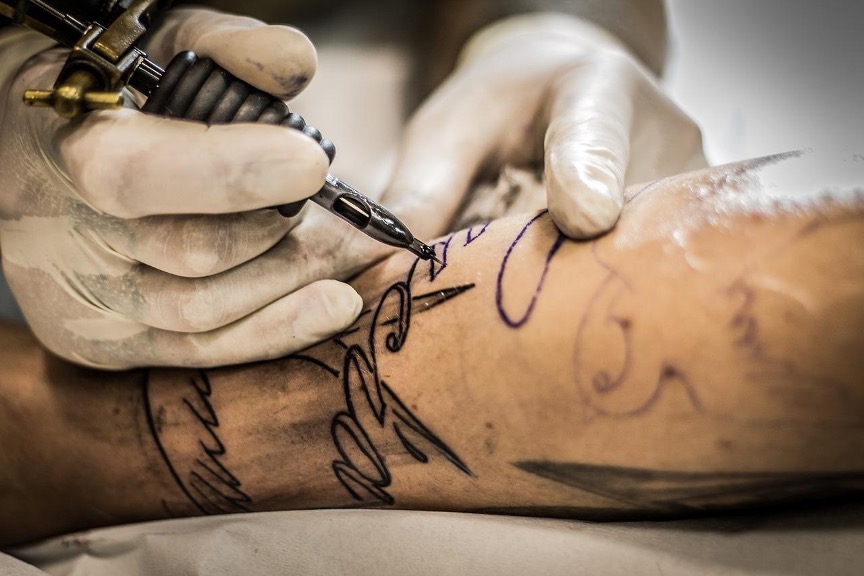There’s a long history of people getting tattoos to cover up birthmarks and scars that they don’t like. So, if you’re unhappy with your veins,…
Can I Tattoo Over My Varicose Veins?

There’s a long history of people getting tattoos to cover up birthmarks and scars that they don’t like. So, if you’re unhappy with your veins, it’s easy to wonder “Can I tattoo over my varicose veins?” However, it’s not quite that simple.
Tattoos don’t produce lumps and bumps in your skin. It’s simply ink that rests between two layers of your skin. Tattoo specialists use a series of needles with ink injection tips to place pigment between your dermis and your epidermis.
This means that tattoos should never get deep enough to change anything below your actual skin. They’re excellent for covering up skin discoloration like a scar or birthmark. However, they can’t cover up the appearance of dark marks from varicose veins.
In addition, there are other problems with tattooing over a varicose vein. Here’s what you need to know about the risks of tattooing unsightly veins and what you can do instead.
Why You Should Never Tattoo Over Varicose Veins
Varicose veins occur near the surface of your skin. Compared to healthy veins, a varicose vein is missing important protection. A normal vein is separated from your skin by a layer of fat, which keeps it from being visible or injured. However, varicose veins are so close to the surface that they don’t have that protective cover.
This means that tattoos are bad news. Tattoos aren’t supposed to puncture all the way through your skin. Still, they involve a needle that’s moving very quickly. It’s all too easy for a stray movement to cause your tattooist to permanently injure you if they’re working over a varicose vein.
There are four primary risks of tattooing over your varicose veins:
Potential for Punctured Veins
The first and most dangerous risk is a punctured vein. Your veins lead directly to your heart. Having a varicose vein punctured can lead to dramatic bleeding.
More importantly, even at the safest tattoo parlor, a punctured vein can become infected. An infected varicose vein can quickly lead to dangerous health problems like sepsis, meaning that a simple tattoo could lead to time in the hospital. They also take a long time to heal, so any injuries will take a while to resolve.
Even if a tattoo doesn’t puncture a vein, all of the activity from tattooing can injure your veins further. Varicose veins are already damaged. Thus, if they’re agitated too much, they can leak blood into the surrounding skin, causing discoloration.
Additional Varicose Vein Pain
Many people find that their varicose veins are painful or uncomfortable. Tattoos, by nature, are painful and cause swelling. Getting a tattoo over your varicose vein increases blood flow to the area. This means that you might experience even more pain from both your tattoo and your veins than you would usually feel from either.
Distorted Tattoos
While it’s not life-threatening, varicose veins also pose the risk of distorting the tattoo you receive. Many varicose veinschange over time. Yet, the tattoo you got to hide a vein may not hide everything effectively after just a year or two. This is especially true if the vein was damaged and the subsequent discoloration spreads to nearby areas.
Similarly, it’s hard to tattoo over veins effectively. Even skilled tattooists can make mistakes trying to tattoo over a moving surface. Once the tattoo is complete, you might be disappointed with the final result.
Difficulty Treating Varicose Veins in the Future
Finally, tattooing over your varicose veins makes it actively harder for you to treat those veins in the future. Varicose vein treatments rely on a clear view of the veins in question. If a specialist can’t easily see where the vein is, they will have difficulty removing it.
This means that tattoos aren’t just a poor way to hide your varicose veins, but that they’re a painful and ineffective masking method that can leave you with permanent scarring, injuries, and no way to cure your condition.
The Difference Between Treating and Tattooing
If you want to stop looking at your veins, then you should consider varicose vein removal. Unlike tattooing, treating your varicose veins addresses the root of the problem. You can get one of several treatments that are designed to get rid of painful and unsightly varicose veins for good.
Tattoos affect the top layer of your skin, but vein removal treatments go deeper. These treatments use either lasers or needles to collapse the problem veins. Once they’re collapsed, your body can heal them and remove them for good. This can solve both your aesthetic and physical complaints at once. Since these treatments are performed by trained professionals, they also don’t carry the risk of damage or infections like tattoos do.
Best of all, once your varicose veins are gone, you can do whatever you want with your skin. If you still want a tattoo, you can get it safely. Instead of letting damaged blood vessels dictate your appearance, you can decide for yourself.
Get Varicose Vein Removal and Stay Safe
It’s natural to dislike the appearance of your varicose veins. However, if you want to improve their appearance, do it right. Reach out to a specialist for advice about improving your veins.
The easiest way to get good advice is to find a varicose vein treatment center or specialist near you. You can use My Vein Treatment’s vein specialist locator tool to find the right person for you. You can look for the specialists near you and choose the one who fits your needs. Get focused, professional help, and wave goodbye to your varicose veins for good.






Responses